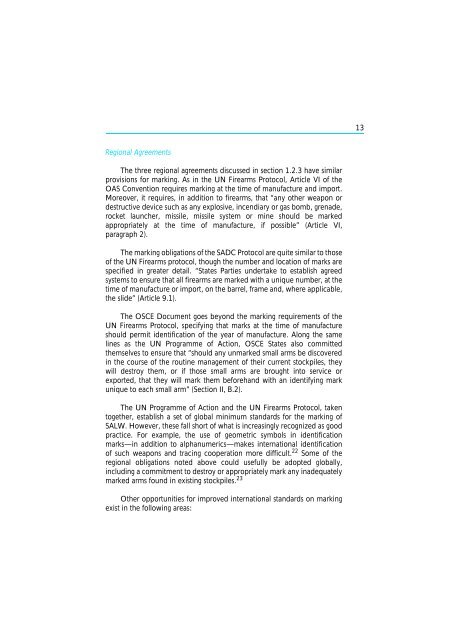The Scope and Implications of a Tracing Mechanism for Small Arms ...
The Scope and Implications of a Tracing Mechanism for Small Arms ...
The Scope and Implications of a Tracing Mechanism for Small Arms ...
Create successful ePaper yourself
Turn your PDF publications into a flip-book with our unique Google optimized e-Paper software.
13<br />
Regional Agreements<br />
<strong>The</strong> three regional agreements discussed in section 1.2.3 have similar<br />
provisions <strong>for</strong> marking. As in the UN Firearms Protocol, Article VI <strong>of</strong> the<br />
OAS Convention requires marking at the time <strong>of</strong> manufacture <strong>and</strong> import.<br />
Moreover, it requires, in addition to firearms, that “any other weapon or<br />
destructive device such as any explosive, incendiary or gas bomb, grenade,<br />
rocket launcher, missile, missile system or mine should be marked<br />
appropriately at the time <strong>of</strong> manufacture, if possible” (Article VI,<br />
paragraph 2).<br />
<strong>The</strong> marking obligations <strong>of</strong> the SADC Protocol are quite similar to those<br />
<strong>of</strong> the UN Firearms protocol, though the number <strong>and</strong> location <strong>of</strong> marks are<br />
specified in greater detail. “States Parties undertake to establish agreed<br />
systems to ensure that all firearms are marked with a unique number, at the<br />
time <strong>of</strong> manufacture or import, on the barrel, frame <strong>and</strong>, where applicable,<br />
the slide” (Article 9.1).<br />
<strong>The</strong> OSCE Document goes beyond the marking requirements <strong>of</strong> the<br />
UN Firearms Protocol, specifying that marks at the time <strong>of</strong> manufacture<br />
should permit identification <strong>of</strong> the year <strong>of</strong> manufacture. Along the same<br />
lines as the UN Programme <strong>of</strong> Action, OSCE States also committed<br />
themselves to ensure that “should any unmarked small arms be discovered<br />
in the course <strong>of</strong> the routine management <strong>of</strong> their current stockpiles, they<br />
will destroy them, or if those small arms are brought into service or<br />
exported, that they will mark them be<strong>for</strong>eh<strong>and</strong> with an identifying mark<br />
unique to each small arm” (Section II, B.2).<br />
<strong>The</strong> UN Programme <strong>of</strong> Action <strong>and</strong> the UN Firearms Protocol, taken<br />
together, establish a set <strong>of</strong> global minimum st<strong>and</strong>ards <strong>for</strong> the marking <strong>of</strong><br />
SALW. However, these fall short <strong>of</strong> what is increasingly recognized as good<br />
practice. For example, the use <strong>of</strong> geometric symbols in identification<br />
marks—in addition to alphanumerics—makes international identification<br />
<strong>of</strong> such weapons <strong>and</strong> tracing cooperation more difficult. 22 Some <strong>of</strong> the<br />
regional obligations noted above could usefully be adopted globally,<br />
including a commitment to destroy or appropriately mark any inadequately<br />
marked arms found in existing stockpiles. 23<br />
Other opportunities <strong>for</strong> improved international st<strong>and</strong>ards on marking<br />
exist in the following areas:
















